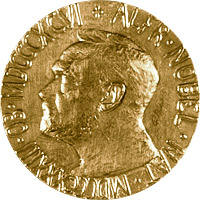The Nobel Prize in Medicine was awarded in three equal parts to Elizabeth Blackburn of the University of California, Carol Greider of the Johns Hopkins University School of Medicine in Baltimore, and Jack Shostak of Boston General Hospital and the Howard Hughes Center.

The Nobel Prize in Medicine was awarded in three equal parts to Elizabeth Blackburn of the University of California, Carol Greider of the Johns Hopkins University School of Medicine in Baltimore, and Jack Shostak of Boston General Hospital and the Howard Hughes Center.
The Nobel Prize for Physiology or Medicine was awarded this year to three scientists who solved an important problem in biology: how the chromosomes replicate themselves perfectly during cell division, and how they protect themselves from wear and tear. The groomsmen showed that the solution lies at the end of the chromosome - the telomeres - and the enzyme that creates them - telomerase.
The long, coiled DNA molecules that carry our genes are compressed into chromosomes. The telomeres are attached at their ends. Elizabeth Blackburn and Jack Shostak discovered that a unique DNA sequence in the telomeres protects the chromosomes from erosion. Carol Greider and Elizabeth Blackburn identified telomerase, the enzyme that builds the telomeres in DNA.
These discoveries explain how the end of the chromosome is protected by the telomeres and they are built by the telomerase.
If the telomeres shorten, the cell ages. On the other hand, if the telomerase activity is high, the length of the telomeres is maintained, and cell aging is delayed. This is the case with cancer cells, which seem to have an eternal life. In contrast, some hereditary diseases are characterized by defective telomerase, which manifests itself in cell damage. The Nobel Prize committee recognized the discovery as a basic mechanism in the cell, a discovery that accelerated and developed new healing strategies.

10 תגובות
Oish, should I be with this is no joke... I'm dyslexic sorry...
Avi:
When I read your first comment I was sure you were joking… and it was pretty funny…
Why do you have to destroy if the second comment 🙂
check my computer again… lol…
white blood,
: )
A local angle: My uncle Tfati today in Givat Ram did his post-doctorate with Dr. Blackburn. His findings were also sensational.
Skeptic, sorry!
I didn't realize someone else had fixed it so I thought there wasn't a problem in the first place.
Thanks for the comment and again, sorry for the misunderstanding.
The unsatisfied skeptic:
It means that they reproduce themselves. In the beginning there were chromosomes, then they became chromosomes-chromosomes, we multiplied. 🙂 🙂 🙂
To the unsatisfied skeptic it is not clear why you always see double. Check your computer.
On my computer it says how chromosomes replicate themselves
I don't understand anything about medicine...
Can someone explain to me what the sentence means?
"How the chromosomes the chromosomes themselves..."
Thanks
I don't need telomeres to know that I'm already old... I still remember being in university in my first degree more than a decade ago when we were told about this new and sensational thing... If I got to know a finding while it was being discovered and wait until they give it a Nobel Prize - that means I'm old.
Retired greetings,
Ami Bachar
Thanks for the attention.
If Elizabeth Blackburn's name can be corrected...
She deserves it for all the work she has done 🙂